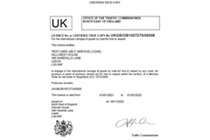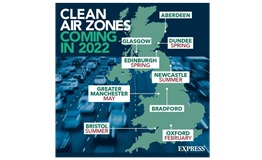Starting a Transport Company in the United Kingdom: A Comprehensive Guide
 The United Kingdom is a hub of business activity, boasting a well-developed infrastructure and a robust economy. Its strategic location, extensive transport networks, and strong trade links make it an attractive place for starting a transport company. Whether you aim to provide freight transport, passenger services, or logistics solutions, launching a transport business in the UK requires careful planning and adherence to specific regulations. This article outlines the key steps, legal obligations, and practical considerations for establishing a transport company in the UK.
The United Kingdom is a hub of business activity, boasting a well-developed infrastructure and a robust economy. Its strategic location, extensive transport networks, and strong trade links make it an attractive place for starting a transport company. Whether you aim to provide freight transport, passenger services, or logistics solutions, launching a transport business in the UK requires careful planning and adherence to specific regulations. This article outlines the key steps, legal obligations, and practical considerations for establishing a transport company in the UK.
Define Your Transport Business Model
Before diving into the legalities, decide the type of transport business you want to establish:
- Freight Transport:
- Transporting goods within the UK or internationally.
- Passenger Transport:
- Operating taxis, buses, or coach services.
- Courier and Delivery Services:
- Managing local or national package delivery.
- Logistics and Supply Chain Management:
- Offering end-to-end transport and warehousing solutions.
Market Research and Business Plan
Conduct thorough market research to identify opportunities and challenges:
- Analyze Demand:
- Study the demand for your chosen services in specific regions or industries.
- Understand Competition:
- Evaluate existing competitors, their services, pricing, and market share.
- Create a Business Plan:
- Outline your goals, operational strategy, target market, and financial projections. Include details about your fleet, staffing, and marketing efforts.
Choose a Legal Structure for Your Business
Select the most suitable legal structure for your business.
- Sole Trader:
-
 Simple setup, but you are personally liable for debts. What you need to do to register as a Sole Trader in United Kingdom, plan for your tax bill and get help and support.
Simple setup, but you are personally liable for debts. What you need to do to register as a Sole Trader in United Kingdom, plan for your tax bill and get help and support.
- Partnership:
- Shared ownership with partners, dividing profits and responsibilities. In a partnership, you and your partner (or partners) personally share responsibility for your business.
- Limited Company (Ltd):
- A separate legal entity offering limited liability protection. A limited company is a company ‘limited by shares’ or ‘limited by guarantee’.
- Limited Liability Partnership (LLP):
- Combines elements of partnerships and limited companies. The main difference between an LLP and a limited company, is that an LLP has the organisational flexibility of a partnership and is taxed as a partnership.
Register Your Company
- Company Register:
-
 Register with Companies House if setting up a limited company. We register company information and make it available to the public.
Register with Companies House if setting up a limited company. We register company information and make it available to the public.
- Unique Taxpayer Reference (UTR):
-
 Apply for a Unique Taxpayer Reference (UTR) from HM Revenue & Customs (HMRC). HMRC is the UK's tax, payments and customs authority.
Apply for a Unique Taxpayer Reference (UTR) from HM Revenue & Customs (HMRC). HMRC is the UK's tax, payments and customs authority.
- VAT Number:
- Register for VAT if your turnover exceeds the threshold (90,000 as of 2024). How to register for VAT
Required Licenses and Permits: Operator’s License
 Obtain an Operator’s Licence (O-Licence) from the Traffic Commissioner if you plan to operate vehicles over 3.5 tonnes. Types of O-Licences: Traffic Commissioners are responsible for the licensing and regulation of those who operate heavy goods vehicles, buses and coaches, and the registration of local bus services.
Obtain an Operator’s Licence (O-Licence) from the Traffic Commissioner if you plan to operate vehicles over 3.5 tonnes. Types of O-Licences: Traffic Commissioners are responsible for the licensing and regulation of those who operate heavy goods vehicles, buses and coaches, and the registration of local bus services.
- Standard National Licence:
- For operating vehicles within the UK. You can also take loaded trailers to or from ports within the UK as part of an international journey, as long as your vehicles do not leave the country. There are 3 different types of operator’s licence for goods vehicles.
- Standard International Licence:
-
 For operating vehicles across EU and non-EU countries. This licence means you can carry your own goods, and other people’s goods, both in the UK and on international journeys. UK Licence for the Community for international road haulage
For operating vehicles across EU and non-EU countries. This licence means you can carry your own goods, and other people’s goods, both in the UK and on international journeys. UK Licence for the Community for international road haulage
- Restricted Licence:
- For businesses transporting their own goods. This licence allows you to carry your own goods, but not other people’s goods.
Driver and Vehicle Compliance
- HGV Driver licenses:
-
 Ensure drivers have the appropriate licenses for the vehicles they will operate (e.g., HGV licenses for heavy goods vehicles). Become a qualified heavy goods vehicle (HGV) or bus driver
Ensure drivers have the appropriate licenses for the vehicles they will operate (e.g., HGV licenses for heavy goods vehicles). Become a qualified heavy goods vehicle (HGV) or bus driver
- Register vehicles:
-
 Register your vehicles with the Driver and Vehicle Licensing Agency (DVLA) and ensure they pass the annual MOT test. Vehicle registration: New and used vehicles
Register your vehicles with the Driver and Vehicle Licensing Agency (DVLA) and ensure they pass the annual MOT test. Vehicle registration: New and used vehicles
Financial Requirements
- Proof of Financial Standing
- To qualify for an O-Licence, you must demonstrate financial stability: £8,000 for the first vehicle and £4,500 for each additional vehicle (amounts subject to change).
- Insurance Coverage
- Obtain mandatory vehicle insurance, including goods-in-transit or passenger liability insurance. Consider additional coverage, such as public liability insurance and employer’s liability insurance.
Compliance with UK and EU Transport Regulations
- Driving and Working Hours
- Adhere to the EU Drivers’ Hours Rules or the UK-specific rules for drivers of commercial vehicles. Use tachographs to monitor driving hours and ensure compliance. European Union (EU) rules on drivers' hours and working time
- Environmental Standards
-
 Ensure your fleet complies with emissions standards, particularly in Clean Air Zones (CAZ) and Ultra Low Emission Zones (ULEZ) in cities like London. Consider investing in low-emission or electric vehicles to future-proof your business. Drive in a clean air zone
Ensure your fleet complies with emissions standards, particularly in Clean Air Zones (CAZ) and Ultra Low Emission Zones (ULEZ) in cities like London. Consider investing in low-emission or electric vehicles to future-proof your business. Drive in a clean air zone
- Health and Safety
- Follow health and safety regulations to protect employees and passengers. Conduct regular risk assessments and provide training to staff.
Fleet Management
- Acquiring Vehicles
- Purchase or lease vehicles that suit your business model. Consider fuel efficiency, load capacity, and maintenance costs.
- Maintenance and Record-Keeping
- Implement a regular maintenance schedule for your fleet. Maintain detailed records of vehicle inspections, repairs, and compliance.
Staffing Your Business
- Hire Qualified Drivers and Staff
- Employ drivers with the appropriate licenses and experience. Recruit administrative staff for scheduling, dispatching, and customer support.
- Employee Contracts and Benefits
- Draft contracts in compliance with UK employment laws. Register employees with HMRC for PAYE (Pay As You Earn) and National Insurance contributions. As an employer, you normally have to operate PAYE as part of your payroll.
Conclusion
Starting a transport company in the UK offers tremendous opportunities, but it requires careful planning, adherence to regulations, and a focus on quality service. By selecting the right business model, acquiring necessary licenses, and leveraging technology, you can build a successful transport business in one of Europe’s most dynamic markets. As the industry evolves toward sustainability and innovation, staying updated with regulations and embracing new trends will ensure your business thrives in the competitive UK transport sector.
eXus Dev